
|
Sale 90
January Pre-Long Beach Auction
| Money of the Bible Collection |
| |
| |
| Lot |
Photo |
Description |
Realized |
Lot 3000 |
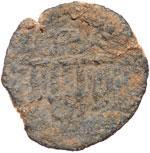 |
Judaea, Hasmonean Kingdom. Mattathias Antigonos. Æ Prutah (1.37 g), 40-37 BCE. Trace of 'Mattatayah the High Priest', showbread table. Reverse: [BAΣIΛEΩΣ ANTIΓONOY], seven-branched menorah. TJC 41; Hendin 1168; Menorah Coin Project ATG 07, engraver C, dies O11/R16 (this coin). Extremely Rare and the only ancient Jewish coin depicting the menorah. Very Fine.
Mattathias Antigonos Prutah Showbread table / menorah.
Fewer than 40 specimens known. These prutot were larger and thinner than the other prutot of Antigonus, but of a similar quantity of copper.
This prutah type is the only coin from antiquity which depicts both the showbread table and the menorah. The objects depicted on the coins of Antigonos predate the destruction of the Temple (70 A.D.) by more than a century. The engravers of the coin may actually have seen the menorah and the showbread table, both of which are depicted in the relief sculpted in the Arch of Titus (c. 82 A.D.).
The menorah and the showbread had been situated opposite one another in front of the entrance to the Holy of Holies (which housed the Ark of the Covenant), and were considered the most sacred of the Temple appurtenances.
"The very boldness of his [Antigonos'] utilization of these images may have indicated just how intense was his struggle for sovereignty against Herod, since he [Antigonos] flouted the traditional convention observed by earlier Jewish rulers against using sacred appurtenances from the Temple on coinage. He did this perhaps in a desperate effort to make the point that the right to mint coins was his as the legitimate heir to the high priesthood, a hereditary post, and a title to which Herod could never lay claim" (C. W. Samuels, The Numismatic Legacy of the Jews (Ed. Paul Rynearson), New York: The Numismatic Review, 2000, 30-32).
Estimated Value $45,000-UP.
View details and enlarged photos
| Unsold |
Lot 3001 |
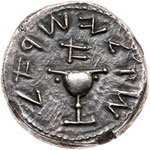 |
Jewish War. Silver Shekel (13.85 g), 66-70 CE. Year 1 (66/7 CE). 'Shekel of Israel' around, '[year] 1' above, omer cup with smooth rim and pellet to either side. Reverse: 'Jerusalem [the] holy', sprig of three pomegranates. TJC 187; Hendin 1354. Excellent metal and toned. Extremely Fine.
Estimated Value $4,000 - 5,000.
Ex Goldberg 41 (27 May 2007), 2495.
View details and enlarged photos
| Realized
$9,106 |
Lot 3002 |
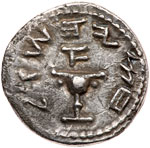 |
Jewish War. Silver 1/2 Shekel (6.27 g), 66-70 CE. Year 1 (66/7 CE). 'Half of a shekel' around, '[year] 1' above, omer cup with smooth rim and pellet to either side. Reverse: 'Jerusalem [the] holy', sprig of three pomegranates. TJC 188; Hendin 1355. Lightly toned. Choice Very Fine.
Estimated Value $2,500 - 3,000.
Ex Goldberg 41 (27 May 2007), 2497.
View details and enlarged photos
| Realized
$8,813 |
Lot 3003 |
 |
Jewish War. Silver 1/2 Shekel (6.79 g), 66-70 CE. Year 2 (67/8 CE). 'Half of a shekel' around, 'year 2' above, omer cup with pearled rim. Reverse: 'Jerusalem the holy', sprig of three pomegranates. TJC 195; Hendin 1359. Well struck and well centered, all lightly toned. Extremely Fine.
Estimated Value $2,500 - 3,000.
Ex Goldberg 41 (27 May 2007), 2502.
View details and enlarged photos
| Realized
$14,100 |
Lot 3004 |
 |
Jewish War. Silver Shekel (14.20 g), 66-70 CE. Year 3 (68/9 CE). 'Shekel of Israel' around, 'year 3' above, omer cup with pearled rim. Reverse: 'Jerusalem the holy', sprig of three pomegranates. TJC 202a; Hendin 1361. Well struck on excellent metal with all detail bold and crisp. A magnificent example with incredible natural iridescent toning. This beauty ranks as one of the finest silver shekels we have ever seen! Superb Nearly Mint State.
Estimated Value $5,000-UP.
Ex Goldberg 41 (27 May 2007), 2503.
View details and enlarged photos
| Realized
$15,275 |
Lot 3005 |
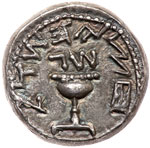 |
Jewish War. Silver 1/2 Shekel (6.57 g), 66-70 CE. Year 3 (68/9 CE). 'Half of a shekel' around, 'year 3' above, omer cup with pearled rim. Reverse: 'Jerusalem the holy', sprig of three pomegranates. TJC 203; Hendin 1362. Well struck with lovely natural multicolor iridescent toning. Superb Extremely Fine.
Estimated Value $4,000 - 5,000.
Ex Goldberg 41 (27 May 2007), 2505.
View details and enlarged photos
| Realized
$10,869 |
Lot 3006 |
 |
Jewish War. Æ Quarter (8.87 g), 66-70 CE. Year 4 (69/70 CE). 'Year four, quarter', two lulav branches. Reverse: 'For the redemtion of Zion', etrog. TJC 213; Hendin 1368. Rare. Dark green patina with earthern highlights. One of the finest examples extant. Extremely Fine.
Estimated Value $3,000 - 4,000.
View details and enlarged photos
| Realized
$5,170 |
Lot 3007 |
 |
Jewish War. Æ Quarter (8.63 g), 66-70 CE. Year 4 (69/70 CE). 'Year four, quarter', two lulav branches. Reverse: 'For the redemtion of Zion', etrog. TJC 213b; Hendin 1368. Rare. Dark brown patina with some lighter highlights. Seldom seen this choice. Nearly Extremely Fine.
Estimated Value $2,000 - 2,500.
Ex Goldberg 41 (27 May 2007), 2509.
View details and enlarged photos
| Realized
$3,995 |
Lot 3008 |
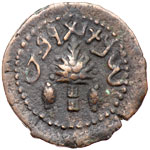 |
Jewish War. Æ Eighth (6.19 g), 66-70 CE. Year 4 (69/70 CE). 'Year four', lulav bunch flanked by two etrogim. Reverse: 'For the redemtion of Zion', chalice with pearled rim. TJC 214a; Hendin 1369. Pleasing reddish-brown patina. Choice Very Fine.
Estimated Value $300 - 400.
Ex Goldberg 41 (27 May 2007), 2511.
View details and enlarged photos
| Realized
$1,351 |
Lot 3009 |
 |
Jewish War. Silver Shekel (13.25 g), 66-70 CE. Year 5 (April-Augustus 70 CE). 'Shekel of Israel' around, 'year 5' above, omer cup with pearled rim. Reverse: 'Jerusalem the holy', sprig of three pomegranates. TJC 215; Hendin 1370 (this coin); Menorah Coin Project FJR 16, dies O1/R1 (this coin illustrated). Extremely Rare and of great importance. Lightly toned. Extremely Fine/Very Fine.
Jewish War Year 5 Shekel
The Year 5 Shekel is extremely rare. According to the Menorah Coin Project, our coin is one of only ten known which share this obverse die, the same die as found on all of the Year 5 shekels excavated at the mountain-top fortress of Masada, thus making a total of only 12 examples from all known dies.
Year 5 shekels are the rarest of all the shekels minted during the First Revolt. There were only four months that year to strike them before Titus captured Jerusalem and destroyed the Temple in the Fall of 70 AD. Nevertheless, during the last months of the siege when all commerce as well as the striking of bronze coins came to a halt, it was important to continue striking coins in silver in order for the Jews to continue to pay the half-shekel Temple tax, as commanded in Exodus 30.13. Several Year 5 Shekels were among the coins excavated at Masada, one of the most famous rebel strongholds against the Romans, which notoriously held out against them for three more years after Vespasian and Titus celebrated their Triumph in 71 A.D. It is therefore known that at least some Jewish fighters were able to escape Jerusalem just before it fell. After the war, it was forbidden to use coins of the revolt, so the shekels were melted down into ingots, for their silver value.
Josephus (de Bello Judaico 7.320-406) tells us that when at length it became evident that the Romans would prevail, the rebel commander of the zealot group known as the Sicarii, Eleazar ben Ya'ir, convinced his men to kill their wives and children and then to commit suicide, thereby depriving the Romans of the glory of taking them captives and sparing themselves from slavery.
Estimated Value $125,000-UP.
Ex Hendin plate coin.
View details and enlarged photos
| Realized
$164,500 |
Lot 3010 |
 |
Bar Kochba Revolt. Silver Sela (14.50 g), 132-135 CE. Year 1 (132/3 CE). 'Jerusalem', tetrastyle facade of the Temple of Jerusalem; Ark of the Covenant in chest form with semicircular lid and short legs, seen from a narrow side. Reverse: 'Year one of the redemption of Israel', lulav with etrog at left. Mildenberg 3 (O1/R3); TJC 218; Hendin 1373. Very rare and an incredibly choice example of this major Judean rarity. Boldly struck on a full flan with nice wide margins on both sides. Superb Extremely Fine.
Bar Kochba Silver Sela Year 1
Most of the silver Bar Kochba coins were overstruck upon tetradrachms of Antioch commonly circulating in Judaea at that time. They served as a declaration of independence from Rome, since only sovereign entities could mint coins in silver, and in their overstriking, the rebels could simultaneously insult the emperor and make nationalistic declarations. David Hendin maintains that the inscription "First Year" had an "aggressive posture… The principal motive of the coins was both political and psychological-to make bold statements of Jewish sovereignty, whether or not it actually existed, to both Jews and Romans."
The Temple façade on the obverse has been variously described as a schematic depiction of the destroyed Temple in Jerusalem, or perhaps as an imaginary sketch of a rebuilt Temple to come. It has been posited that the item within the two central columns is the Ark of the Covenant, an ark holding Torah scrolls, the showbread table, or possibly a stylized generic ritual chalice.
On the reverse of the sela are represented the Four Species, the most important articles Jews utilize in the ritual observance of Sukkot, known as "The Holiday" while the Temple stood in Jerusalem.
The Four Species are here depicted as the central object, the lulav (a bundle comprised of three of the species) and, to its left, the etrog (the fourth species). The objects used in the ritual celebration of the festival of Sukkot is commanded in Leviticus 23:40-41: "You shall take for yourselves on the first day [of Sukkot] the fruit of the citron tree (etrog), the branches of the date palm (tamar), twigs of a plaited tree [myrtle] (aravot), and brook willows (hasadim)… You shall celebrate it [Sukkot] as a festival for God …[This is] an eternal decree for your generations."
After the destruction of the Temple (70 C.E.), Rabbi Yohanan ben Zakkai (who had escaped from the besieged Jerusalem in a coffin) ordered that the ceremony of the Four Species should be carried out as a memorial to the Temple. (Mehahot 65a).
Estimated Value $60,000-UP.
View details and enlarged photos
| Realized
$117,500 |
Lot 3011 |
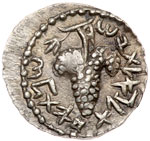 |
Bar Kochba Revolt. Silver Zuz (3.41 g), 132-135 CE. Year 1 (132/3 CE). 'Year one of the redemption of Israel', grape bunch on vine with small leaf. Reverse: 'Eleazar the priest', jug with handle; willow branch at right. Mildeberg II.2.4 (O2/R1; this coin); TJC 219; Hendin 1374 (this coin). Very rare. Boldly struck with all the letters clearly defined. Lightly toned. Extremely Fine.
The branch to the right of the jug has traditionally been identified as a palm branch. In "The Temple Willow-Branch Ritual Depicted on Bar Kochba Denarii," INJ 16 (2007-2008), pp. 131-5, Y. Adler argues that it is in fact a willow branch, and represents the willow branch ceremony that took place along with the water ceremony (represented by the jug) at the Temple altar during the Feast of Tabernacles.
Bar Kochba Silver Zuz Year 1
Mildenberg cites only 9 specimens with this die combination. The obverse inscription "Eleazar the Priest" on a year 1 coin, is extremely rare, relative to the dozens of year 1 zuzim inscribed with "Shim'on."
Who was this Eleazar ? Some scholars think that he may have been Eleazar of Mod'in, the uncle of bar Kochba mentioned in rabbinic literature. Whoever he was, "the prominence given to a high priest on the coinage was surely connected with the rebels' aim of restoring the Temple and its cult, and Eleazar was clearly the religious leader, parallel but subordinate to the political military leader" (E. Mary Smallwood, Jews under Roman Rule from Pompey to Diocletian: A study in political relations (Studies in Judaism in Late Antiquity, ed. Jacob Neusner, volume. 20). Reprint with corrections. Leiden: E.J. Brill, 1981, p. 441).
Mildenberg, in his seminal work, noted that it is possible that Bar Kochba's men knew of the rebel coins of the Jewish War (The Coinage of the Bar Kokhba War, Aarau: Verlag Sauerlaender, 1984, p. 68). Possibly as well, the engravers knew of coins of the Hasmonaeans, with the inscriptions including the appellation "High Priest," since recently a hoard was discovered in western Jerusalem, wherein Bar Kochba coins had been buried with a coin of the Jewish War as well as with a bronze prutah of John Hyrcanus. The Bar Kochba coin of Year 1, inscribed with "Eleazar, the Priest" would comply with Mildenberg's idea: that the minters of the Bar Kochba coins chose to propogate by their coins taken as a group a plan that conformed either to the memory of the destroyed Temple or to their dream of a new Temple to come.
See discussion in: B. Zissu, R. Langford, and A. Frumkin, "Archaeological Remains of the Bar Kokhba Revolt in the Te'omim Cave (Mugharet Umm et Tueimin)," Journal of Jewish Studies, Vol. LXII, No. 2/Autumn 2011, 262-283.
Estimated Value $25,000-UP.
Ex Hendin plate coin; Ex A. Spaer Collection; Beit Mirsim Hoard (Hebron Hills, 1973-1974).
View details and enlarged photos
| Realized
$41,125 |
Lot 3012 |
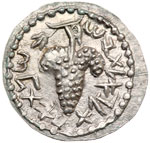 |
Bar Kochba Revolt. Silver Zuz (3.24 g), 132-135 CE. Year 1/2 hybrid (132/3-133/4 CE). 'Year one of the redemption of Israel', grape bunch on vine with small leaf. Reverse: 'Year two of the freedom of Israel', palm branch. Mildeberg 10 (O2/R9); TJC 237; Hendin 1382. Very Rare. Well struck on a nice broad flan and well centered on both sides. A marvelous specimen! Nearly Mint State.
Estimated Value $9,000-UP.
View details and enlarged photos
| Realized
$18,213 |
Lot 3013 |
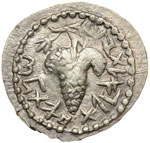 |
Bar Kochba Revolt. Silver Zuz (3.01 g), 132-135 CE. Year 1/2 hybrid (132/3-133/4 CE). 'Year one of the redemption of Israel', grape bunch on vine with small leaf. Reverse: 'Year two of the freedom of Israel', wide lyre with three strings, four dots on sound box. Mildeberg 11 (O2/R7); TJC 236; Hendin 1383. Very rare. Well struck on a nice broad flan with wide margins on both sides. Lightly toned. Extremely Fine.
Estimated Value $13,000 - 15,000.
View details and enlarged photos
| Unsold |
Lot 3014 |
 |
Bar Kochba Revolt. Silver Zuz (3.05 g), 132-135 CE. Year 2/1 hybrid (132/3-133/4 CE). 'Shma' (abbreviating Shi'mon), in triangular form within a wreath of thin branches wrapped around eight almonds, medallion at top, and tendrils below. Reverse: 'Eleazar the priest', fluted jug with handle on left; willow branch at right. Mildeberg 3 (O3/R1); TJC 235; Hendin 1384. Rare. Boldly struck and well centered with underlying luster present. Superb Extremely Fine.
Estimated Value $4,000 - 5,000.
View details and enlarged photos
| Realized
$6,169 |
Lot 3015 |
 |
Bar Kochba Revolt. Silver Sela (14.34 g), 132-135 CE. Year 2 (133/4 CE). 'Jerusalem', tetrastyle facade of the Temple of Jerusalem; Ark of the Covenant in chest form with semicircular lid and short legs, seen from a narrow side; star above. Reverse: 'Year two of the freedom of Israel', lulav with etrog at left. Mildeberg 19 (O4/R13); TJC 230; Hendin 1386. Boldly struck with underlying luster present. Lightly toned. Superb Extremely Fine.
Estimated Value $7,000 - 9,000.
View details and enlarged photos
| Realized
$12,338 |
Lot 3016 |
 |
Bar Kochba Revolt. Silver Sela (14.71 g), 132-135 CE. Year 2 (133/4 CE). 'Jerusalem', tetrastyle facade of the Temple of Jerusalem; Ark of the Covenant in chest form with semicircular lid and short legs, seen from a narrow side; star above. Reverse: 'Year two of the freedom of Israel', lulav with etrog at left. Mildeberg 14 (O3/R8); TJC 230a; Hendin 1387. Rare - only five specimens listed in Mildenberg. Well struck on a slightly irregular size flan with underlying luster still present. Superb Extremely Fine.
Estimated Value $5,000 - 6,000.
View details and enlarged photos
| Realized
$9,694 |
Lot 3017 |
 |
Bar Kochba Revolt. Silver Sela (13.20 g), 132-135 CE. Year 2 (133/4 CE). 'Jerusalem', tetrastyle facade of the Temple of Jerusalem; Ark of the Covenant in chest form with semicircular lid and short legs, seen from a narrow side; star above. Reverse: 'Year two of the freedom of Israel', lulav with etrog at left. Mildeberg 21 (O4/R14); TJC 230a; Hendin 1387. Boldly struck and well centered, lightly toned. Extremely Fine.
Estimated Value $5,000 - 6,000.
View details and enlarged photos
| Realized
$9,400 |
Lot 3018 |
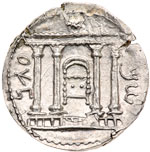 |
Bar Kochba Revolt. Silver Sela (14.60 g), 132-135 CE. Year 2 (133/4 CE). 'Shim'on', tetrastyle facade of the Temple of Jerusalem; Ark of the Covenant in chest form with semicircular lid and short legs, seen from a narrow side; star above. Reverse: 'Year two of the freedom of Israel', lulav with etrog at left. Mildeberg 38 (O8/R27); TJC 233; Hendin 1388. Rare - only five specimens listed in Mildenberg. Boldly struck on a nice wide flan with a couple of flan cracks around the edges as made. Underlying luster still present. Superb Extremely Fine.
Estimated Value $5,000 - 6,000.
View details and enlarged photos
| Realized
$7,638 |
Lot 3019 |
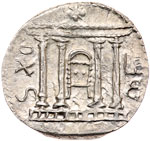 |
Bar Kochba Revolt. Silver Sela (13.78 g), 132-135 CE. Year 2 (133/4 CE). 'Shim'on', tetrastyle facade of the Temple of Jerusalem; Ark of the Covenant in chest form with semicircular lid and short legs, seen from a narrow side; star above. Reverse: 'Year two of the freedom of Israel', lulav with etrog at left. Mildeberg 28 (O6/R19); TJC 230; Hendin 1388. Rare. Lightly toned with underlying luster present. Extremely Fine.
Estimated Value $5,000 - 6,000.
View details and enlarged photos
| Realized
$6,463 |
Lot 3020 |
 |
Bar Kochba Revolt. Silver Sela (13.65 g), 132-135 CE. Year 2 (133/4 CE). 'Shim'on', tetrastyle facade of the Temple of Jerusalem; Ark of the Covenant in chest form with semicircular lid and short legs, seen from a narrow side; star above. Reverse: 'Year two of the freedom of Israel', lulav with etrog at left. Cf. Mildeberg 38/36 (O8/R26) die combination not recorded; TJC 230; Hendin 1388. Extremely Rare new die combination unknown to Mildenberg. Delicately toned with underlying luster still present. Extremely Fine.
Mildenberg notes that this obverse die was recut twice, the first time having the center of the balustrade reengraved, the second time having the first two letters reengraved as well as a die flaw in one of the columns removed. Of the first recutting, die O8', Mildenberg recorded several dozen specimens paired with one of two reverse dies, R26 and R27. Similarly, of the second recutting, die O8'', he knew of just five specimens, but all were paired with a single reverse die, R27. This would seemingly indicate a chronological progression of R26 followed by R27, but our coin illustrates the fallacy of this assumption as it is a new die combination pairing the second recutting of the obverse die, O8, with the reverse die R26.
Estimated Value $5,000 - 6,000.
View details and enlarged photos
| Realized
$8,225 |
Lot 3021 |
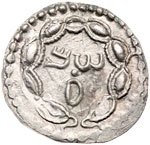 |
Bar Kochba Revolt. Silver Zuz (3.18 g), 132-135 CE. Year 2 (133/4 CE). 'Shim'' (abbreviating Shi'mon), in triangular form within a wreath of thin branches wrapped around eight almonds, medallion at top, and tendrils below. Reverse: 'Year two of the freedom of Israel', wide lyre with three strings, four dots on sound box. Mildeberg 13 (O4/R7); TJC 238; Hendin 1389. Rare. Lightly toned. Extremely Fine.
Estimated Value $3,000 - 3,500.
View details and enlarged photos
| Realized
$5,170 |
Lot 3022 |
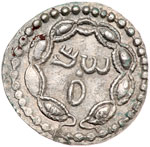 |
Bar Kochba Revolt. Silver Zuz (3.27 g), 132-135 CE. Year 2 (133/4 CE). 'Shim'' (abbreviating Shi'mon), in triangular form within a wreath of thin branches wrapped around eight almonds, medallion at top, and tendrils below. Reverse: 'Year two of the freedom of Israel', palm branch. Mildeberg 14 (O4/R9); TJC 245; Hendin 1390. Extremely Rare - only two specimens recorded by Mildenberg. Well struck with nice wide margins, lightly toned. Superb Extremely Fine.
Mildenberg notes that the "completely straight palm branch on [reverse die] R9 is unique throughout the coinage."
Estimated Value $2,000 - 2,500.
View details and enlarged photos
| Realized
$10,869 |
Lot 3023 |
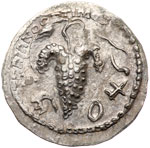 |
Bar Kochba Revolt. Silver Zuz (3.16 g), 132-135 CE. Year 2 (133/4 CE). 'Shim'on', grape bunch on vine with small leaf and tendril. Reverse: 'Year two of the freedom of Israel', wide lyre with three strings. Mildeberg 43 (O9/R25); TJC 242; Hendin 1393. Rare. Overstruck on a denarius of Trajan with part of the obverse legend and face showing. Rare. Lightly toned. Extremely Fine.
Estimated Value $2,000 - 2,500.
View details and enlarged photos
| Realized
$4,935 |
Lot 3024 |
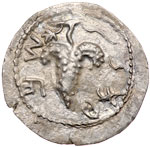 |
Bar Kochba Revolt. Silver Zuz (2.99 g), 132-135 CE. Year 2 (133/4 CE). 'Shim'on', grape bunch on vine with small leaf and tendril. Reverse: 'Year two of the freedom of Israel', palm branch. Mildeberg 40 (O7/R12); TJC 248; Hendin 1394 corr. (rev. description). Lightly toned. Extremely Fine.
Estimated Value $700 - 800.
View details and enlarged photos
| Realized
$1,293 |
Lot 3025 |
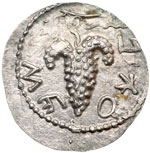 |
Bar Kochba Revolt. Silver Zuz (3.12 g), 132-135 CE. Year 2 (133/4 CE). 'Shim'on', grape bunch on vine with small leaf and tendril. Reverse: 'Year two of the freedom of Israel', palm branch. Mildeberg 49 (O10/R29); TJC 248; Hendin 1394 corr. (rev. description). Underlying luster present. Extremely Fine.
Estimated Value $700 - 800.
View details and enlarged photos
| Realized
$1,410 |
Lot 3026 |
 |
Bar Kochba Revolt. Silver Zuz (2.67 g), 132-135 CE. Year 2 (133/4 CE). 'Shim'on', grape bunch on vine with small leaf and tendril. Reverse: 'Year two of the freedom of Israel', fluted jug with handle on left; willow branch at right. Mildeberg 37 (O6/R18); TJC 253; Hendin 1395. Extremely Rare - only four specimens recorded by Mildenberg. Lightly toned. Extremely Fine.
Estimated Value $900 - 1,000.
View details and enlarged photos
| Realized
$2,820 |
Lot 3027 |
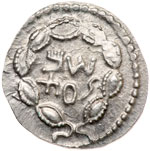 |
Bar Kochba Revolt. Silver Zuz (3.32 g), 132-135 CE. Year 2 (133/4 CE). 'Shim'on', in two lines within a wreath of thin branches wrapped around eight almonds, medallion at top, and tendrils below. Reverse: 'Year two of the freedom of Israel', fluted jug with handle on left; willow branch at right. Mildeberg - (O14/R26), die combination not recorded); Kaufman 12 (O14/R26); TJC -; Hendin -. Extremely Rare. Underyling luster present and lightly toned. Extremely Fine.
Estimated Value $2,500-UP.
View details and enlarged photos
| Realized
$3,055 |
Lot 3028 |
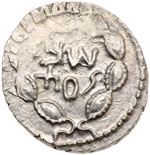 |
Bar Kochba Revolt. Silver Zuz (3.23 g), 132-135 CE. Year 2 (133/4 CE). 'Shim'on', in two lines within a wreath of thin branches wrapped around eight almonds, medallion at top, and tendrils below. Reverse: 'Year two of the freedom of Israel', palm branch. Mildeberg 59 (O14/R29); TJC 246; Hendin 1401. Overstruck on a drachm of Trajan from Bostra. Lightly toned. Choice Very Fine.
Estimated Value $400 - 500.
View details and enlarged photos
| Realized
$1,351 |
Lot 3029 |
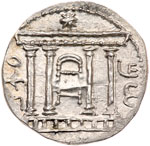 |
Bar Kochba Revolt. Silver Sela (14.35 g), 132-135 CE. Undated, attributed to year 3 (134/5 CE). 'Shim'on', tetrastyle facade of the Temple of Jerusalem; Ark of the Covenant in chest form with semicircular lid and short legs, seen from a narrow side; star above. Reverse: 'For the freedom of Israel', lulav with etrog at left. Mildeberg 54 (O13/R40); TJC 267; Hendin 1411. Rare - only five specimens recorded by Mildenberg. Boldly struck with the lulav in high relief and underlying luster present. A marvelous example! Superb Nearly Mint State.
Estimated Value $4,000 - 6,000.
View details and enlarged photos
| Realized
$16,450 |
Lot 3030 |
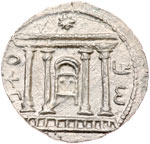 |
Bar Kochba Revolt. Silver Sela (14.22 g), 132-135 CE. Undated, attributed to year 3 (134/5 CE). 'Shim'on', tetrastyle facade of the Temple of Jerusalem; Ark of the Covenant in chest form with semicircular lid and short legs, seen from a narrow side; star above. Reverse: 'For the freedom of Israel', lulav with etrog at left. Mildeberg 63 (O14/R48); TJC 267; Hendin 1411. Lightly toned with underlying luster still present. Nearly Mint State.
Estimated Value $4,000 - 6,000.
View details and enlarged photos
| Realized
$8,519 |
Lot 3031 |
 |
Bar Kochba Revolt. Silver Sela (14.63 g), 132-135 CE. Undated, attributed to year 3 (134/5 CE). 'Shim'on', tetrastyle facade of the Temple of Jerusalem; Ark of the Covenant in chest form with semicircular lid and short legs, seen from a narrow side; star above. Reverse: 'For the freedom of Israel', lulav with etrog at left. Mildeberg 73 (O11/R42); TJC 267; Hendin 1411. Rare - only five specimens recorded by Mildenberg. Well struck with the lulav in high relief. Underlying luster present. Nearly Mint State.
Estimated Value $4,000 - 6,000.
View details and enlarged photos
| Realized
$11,456 |
Lot 3032 |
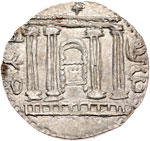 |
Bar Kochba Revolt. Silver Sela (14.00 g), 132-135 CE. Irregular issue. Undated, attributed to year 3 (134/5 CE). 'Shim'on', tetrastyle facade of the Temple of Jerusalem; Ark of the Covenant in chest form with semicircular lid and short legs, seen from a narrow side; star above. Reverse: 'For the freedom of Israel', lulav with etrog at left. Mildeberg 102 (O23/R77); TJC 268; Hendin 1411a. Rare. A very choice example of the "Irregular issue" with no striking flaws. Lightly toned. Extremely Fine.
Estimated Value $6,000 - 8,000.
View details and enlarged photos
| Realized
$7,050 |
Lot 3033 |
 |
Bar Kochba Revolt. Silver Sela (14.27 g), 132-135 CE. Undated, attributed to year 3 (134/5 CE). 'Shim'on', tetrastyle facade of the Temple of Jerusalem; Ark of the Covenant in chest form with semicircular lid and short legs, seen from a narrow side; wavy line above. Reverse: 'For the freedom of Israel', lulav with etrog at left. Mildeberg 90 (O17/R69); TJC 269; Hendin 1413. Rare - only four specimens recorded by Mildenberg. Virtually as struck with underlying frosty mint luster and lightly toned. Extremely Fine.
Estimated Value $4,000 - 6,000.
View details and enlarged photos
| Realized
$9,694 |
Lot 3034 |
 |
Bar Kochba Revolt. Silver Zuz (3.36 g), 132-135 CE. Undated, attributed to year 3 (134/5 CE). 'Shim'on', in two lines within a wreath of thin branches wrapped around eight almonds, medallion at top, and tendrils below. Reverse: 'For the freedom of Jerusalem', two trumpets upright. Mildeberg 67 (O14/R39); TJC 276b; Hendin 1417. Lustrous. Superb Extremely Fine.
Estimated Value $500 - 600.
View details and enlarged photos
| Realized
$3,055 |
Lot 3035 |
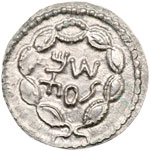 |
Bar Kochba Revolt. Silver Zuz (3.25 g), 132-135 CE. Undated, attributed to year 3 (134/5 CE). 'Shim'on', in two lines within a wreath of thin branches wrapped around eight almonds, medallion at top, and tendrils below. Reverse: 'For the freedom of Jerusalem', fluted jug with handle on left; willow branch at right. Mildeberg 73 (O14/R45); TJC 283b; Hendin 1418. Lustrous Superb Extremely Fine.
Estimated Value $500 - 600.
View details and enlarged photos
| Realized
$2,350 |
Lot 3036 |
 |
Bar Kochba Revolt. Silver Zuz (3.37 g), 132-135 CE. Undated, attributed to year 3 (134/5 CE). 'Shim'on', in two lines within a wreath of thin branches wrapped around eight almonds, medallion at top, and tendrils below. Reverse: 'For the freedom of Jerusalem', elongated lyre with three strings. Mildeberg 70 (O14/R42); TJC 272; Hendin 1419. Extremely Fine.
Estimated Value $500 - 600.
View details and enlarged photos
| Realized
$2,233 |
Lot 3037 |
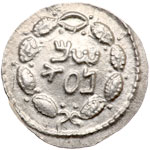 |
Bar Kochba Revolt. Silver Zuz (3.22 g), 132-135 CE. Undated, attributed to year 3 (134/5 CE). 'Shim'on' (but letters arranged Shim'na), in two lines within a wreath of thin branches wrapped around eight almonds, medallion at top, and tendrils below, pair of dots, one inside and one outside, between each section. Reverse: 'For the freedom of Jerusalem', elongated lyre with three strings. Mildeberg 101 (O16/R69); TJC 272a; Hendin 1424. Delicately toned. Superb Extremely Fine.
Estimated Value $500 - 600.
View details and enlarged photos
| Realized
$1,645 |
Lot 3038 |
 |
Bar Kochba Revolt. Silver Zuz (3.33 g), 132-135 CE. Undated, attributed to year 3 (134/5 CE). 'Shim'on', in two lines within a wreath of thin branches wrapped around eight almonds, medallion at top, and tendrils below, pair of dots, one inside and one outside, between each section. Reverse: 'For the freedom of Jerusalem', palm branch. Mildeberg 122 (O18/R80); TJC 279; Hendin 1425. Overstruck on a denarius of Hadrian. Lightly toned. Extremely Fine.
Estimated Value $500 - 600.
View details and enlarged photos
| Realized
$1,175 |
Lot 3039 |
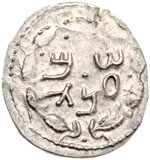 |
Bar Kochba Revolt. Silver Zuz (3.34 g), 132-135 CE. Undated, attributed to year 3 (134/5 CE). 'Shim'on', in two lines within a wreath of thin branches wrapped around eight almonds, medallion at top, and tendrils below, pair of dots, one inside and one outside, between each section. Reverse: 'For the freedom of Jerusalem', fluted jug with handle on left; no willow branch. Mildeberg 132 (O19/R92); TJC 284; Hendin 1428. Extremely Fine.
Estimated Value $500 - 600.
View details and enlarged photos
| Realized
$1,146 |
Lot 3040 |
 |
Bar Kochba Revolt. Silver Zuz (3.21 g), 132-135 CE. Undated, attributed to year 3 (134/5 CE). 'Shim'on', grape bunch on vine with tendril and small leaf. Reverse: 'For the freedom of Jerusalem', palm branch. Mildeberg 151 (O11/R71); TJC 281; Hendin 1430. Extremely Rare - Mildenberg recorded just two specimens. Underlying luster present. Superb Extremely Fine.
Estimated Value $600 - 700.
View details and enlarged photos
| Realized
$1,880 |
Lot 3041 |
 |
Judaea, Bar Kochba Revolt. Silver Zuz (3.40 g), 132-135 CE. Undated, attributed to year 3 (134/5 CE). 'Shim'on', grape bunch on vine with tendril and small leaf. Reverse: 'For the freedom of Jerusalem', fluted jug with handle on left; willow branch at right. Mildeberg 161 (O21/R81); TJC 285; Hendin 1433. Overstruck on a denarius of Domitian. Struck on a huge flan with wide margins on both sides. Luster still present. Extremely Fine.
Estimated Value $500 - 600.
View details and enlarged photos
| Realized
$1,880 |
Lot 3042 |
 |
Judaea, Bar Kochba Revolt. Silver Zuz (3.34 g), 132-135 CE. Undated, attributed to year 3 (134/5 CE). 'Shim'on', grape bunch on vine with tendril and small leaf. Reverse: 'For the freedom of Jerusalem', fluted jug with handle on left; no willow branch. Mildeberg 164 (O21/R89); TJC 286; Hendin 1434. Very Fine.
Estimated Value $400 - 500.
View details and enlarged photos
| Realized
$911 |
Lot 3043 |
 |
Vespasian. Gold Aureus (7.08 g), AD 69-79. 'Judaea Capta' type. Rome, AD 69/70. IMP CAESAR VESPASIANVS AVG, laureate head of Vespasian right. Reverse: IVDAEA in exergue, Jewess seated right, head resting on hand in attitude of mourning; behind, trophy. RIC 1; BMC 31-4; BN 20-2; Calicó 643; Hendin 1464 (this coin). Boldly struck with excellent detail throughout. Some scattered marks about, none too serious with underlying luster present. About Extremely Fine.
Mourning JUDAEA with military trophy.
First coin of the standard 'Judaea Capta' series. In the 'Judaea Capta' coinage, the seated personified Judaea evokes the iconographic language of the defeated and degraded prisoner. The conquered province type has its own set of gestures expressing a mournful or abject context, which are derived from Roman funerary iconography. They include an attitude formed by the resting of the chin in the hand, a pose that evokes pensiveness, uncertainty, and grief with overtones of repentance or lamentation. Additionally, the mourner is shown with hunched shoulders, and a bowed and covered head. The depiction of the personified province recollects the Biblical description of the besieged Jerusalem by the prophet Isaiah (c. 700 B.C.E.): "For Jerusalem is ruined, and Judah is fallen… Thy men shall fall by the sword and thy mighty in the war. And her gates shall lament and mourn, and she, being desolate, shall sit upon the ground" (Isaiah 3:8-9; 25-26).
The imposing military trophy standing to the left of the picture looms over the back of the vanquished Judaea, taunting the humiliated figure, re-enforcing the fact that the weapons used to resist Rome are now spoils to the victors; they no longer hold power.
Estimated Value $35,000-UP.
Ex Hendin plate coin.
View details and enlarged photos
| Realized
$61,688 |
Lot 3044 |
 |
Vespasian. Gold Aureus (7.32 g), AD 69-79. 'Judaea Capta' type. Lugdunum, AD 71. IMP CAESAR VESPASIANVS AVG TR P, laureate head of Vespasian right. Reverse: TRIVMP AVG in exergue, emperor on triumphal quadriga right, holding palm and eagle-tipped scepter, being crowned by Victory standing behind him and accompanied by trumpeter; before horses, soldier escorting captive with arms bound behind his back. RIC 1127; BMC 397; BN 17; Calicó 689; Hendin 1475. One of the rarest types of Judaea Capta coinage, this handsome example was struck immediately after the Jewish War concluded. Boldly struck in high relief with excellent detail. Delicately toned. Choice Very Fine.
Simon bar Giora Aureus
This very rare 'Judaea Capta' - themed aureus, minted to commemorate the recently concluded Jewish War, is most notable for its reverse type. The exergual inscription simply reads: TRIVMP AVG (Triumph of Augustus [Vespasian]). Depicted with particular clarity is the imperial quadriga in the way it would have appeared in the triumphal procession, preceded by a soldier who looks back at the emperor, while escorting a captive with hands bound behind. Robert Deutsch (BAR Jan/Feb 2010, 51-53) identifies the captive as the most important leader of Jerusalem in the Jewish War, Simon bar Giora.
The triumph celebrated by Vespasian and Titus in 71 A.D. was a magnificent showcase of the abundance gleaned from the victory over the destroyed province. Booty taken back to Rome after the war was prodigious. When the Romans entered the Temple court, "so glutted with plunder were the troops, one and all, that throughout Syria the standard of gold was depreciated to half its former value" (Josephus, de Bello Judaico, 6.316-322).
The triumph itself was described in vivid detail by Josephus, who was an eye-witness to the event (de Bello Judaico, 7.24): "…as dawn was breaking [Titus and Vespasian] emerged, crowned with laurel wreaths and wearing the time-honored purple clothes…. It is impossible to do justice in the description of the number of things to be seen and the magnificence of everything… For almost all the remarkable and valuable objects which have ever been collected … were on that day massed together, affording a clear demonstration of the might of the Roman Empire. The quantities of silver, gold and ivory, worked into every conceivable form, were not like those usually carried in a triumph, but resembled, as it were, a running river of wealth… The greatest amazement was by the floats… For many were three or four stories high… Standing on his individual float was the commander of each of the captured cities showing the way he had been taken prisoner… Spoil in abundance was carried past. None of it compared with that taken from the Temple in Jerusalem, a golden table [the showbread table], and a golden lamp stand [the menorah]… The Law [Torah; The Five Books of Moses] was carried last of all the spoil.
The procession culminated at the Temple of Jupiter Capitolinus… where they still had to wait for the traditional moment when the news was brought of the death of the enemy leader. In this case he was Simon bar Giora, who had passed in procession with captives and had been dragged under the lash, with his head in a noose, to a spot near the Forum. That is the traditional place at Rome for the execution of those condemned to death for war crimes. When his end was announced and a general cheer had arisen, they started the sacrifices…."
Estimated Value $50,000-UP.
Ex Goldberg 41 (27 May 2007), 2786.
View details and enlarged photos
| Realized
$91,650 |
Lot 3045 |
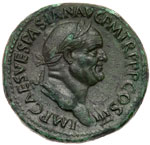 |
Vespasian. Æ Sestertius (26.22 g), AD 69-79. 'Judaea Capta' type. Rome, AD 71. IMP CAES VESPASIAN AVG P M TR P P P COS III, laureate head of Vespasian right. Reverse: IVDAEA CAPTA, S C in exergue, palm tree; to left, emperor standing right, foot on helmet, holding spear and parazonium; to right, Jewess�in attitude of mourning seated right on cuirass. RIC 167; BMC 543; BN 497-8; Hendin 1504. Beautiful dark green patina. A magnificent specimen! Superb Extremely Fine.
The elements of the reverse type include a palm-tree flanked on the left by the emperor, with his foot on a helmet, and on the right, by the personified Judaea, seated to right on a cuirass. In the scene, the emperor is representative of the vast power of Rome. His foot on a helmet of the defeated enemy and his large parazonium symbolize the might of the dominant victor. The emperor is drawn on a much larger scale than is the much more diminutively wrought personified Judaea. The downcast Judaea is seated upon a cuirass, which here represents the spoils of her defeated army. Her pose connotes the humiliation of destruction, captivity and exile. This image was designed both as an exultation of the empire and as a warning to any other province that might be contemplating rebellion.
Estimated Value $30,000-UP.
Ex NAC 40 (16 May 2007), 679.
View details and enlarged photos
| Unsold |
Lot 3046 |
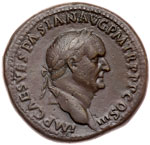 |
Vespasian. Æ Sestertius (26.97 g), AD 69-79. 'Judaea Capta' type. Rome, AD 71. IMP CAES VAESPASIAN AVG P M TR P P P COS III, laureate head of Vespasian right. Reverse: IVDEA CAPTA, S C in exergue, palm tree; to left, emperor standing right, foot on cuirass, holding spear and parazonium; to right, Jewess�in attitude of mourning seated right on cuirass. RIC 168, note; cf. BMC 545-7 (foot on helmet); cf. BN 499 (same); Kraay A10/P98 (die combination not recorded); Hendin 1504a. An extremely rare variety of the IVDEA legend reverse. Uniform chocolate brown patina with some expert light smoothing in the fields. Choice Very Fine.
RIC notes that Kraay, in his unpublished doctoral dissertation (1953), records one reverse die (P98) showing Vespasian's foot resting on a cuirass rather than the normal helmet. He recorded just two examples, nos. 249 and 252 (from Cambridge and Copenhagen, respectively). Both share the reverse die with our coin, but were struck from different obverse dies.
Vespasian Sestertius IVDEA CAPTA inscription
A remarkably rare spelling of the obverse inscription: IVDEA CAPTA; only one die is listed in RIC. This interesting variety of Vespasian's 'Judaea Capta' series is worthy of note, since it expresses a linguistic phenomenon occurring in the Latin-speaking world.
The more common inscription of IVDAEA is a Latinization of the Greek word Iudaia, with both the 'ai' in the Greek and the 'ae' in the Latin diphthong having a value similar to the long 'i' in 'high.'
In the late Republic and early Empire, in common speech as well as in non-formal writing, the 'ae' morphed into 'e'. This change is attested as early as in the essays of Marcus Terentius Varro, and the comedies of Plautus, as well as in graffiti of the period. Though there was an attempt for centuries to maintain the diphthong 'ae' in formal spelling, the Romance language evidence shows that eventually the linguistic change to 'e' had eventually spread across the entire Latin-speaking world.
We would like to suggest that the variant spelling of IVDEA on this sesterius, rather than the more formal spelling of IVDAEA, reflects a 'creeping in' of the parallel spelling of 'e' instead of 'ae,' the written representation of a pronunciation that was current in many areas of the empire in the period.
Estimated Value $8,000 - 10,000.
Ex Gemini V (6 January 2009), 262.
View details and enlarged photos
| Realized
$14,688 |
Lot 3047 |
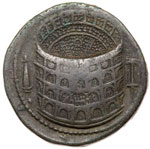 |
Titus. Æ Sestertius (25.87 g), AD 79-81. Rome, AD 80/1. View of the Amphitheatrum Flavium (the Colosseum) between the Meta Sudans, on left, and porticoed building, on right; the exterior of the monument showing four tiers with a varying number of arches, some empty and some with statuary; the interior shows the seating filled with spectators, steps, and the emperor's viewing box. Reverse: IMP T CAES VESP AVG P M TR P P P COS VIII, S C across field, emperor seated left on curule chair, holding branch and scroll; around, various arms. RIC 184; BMC 190, pl. 50, 2 (same dies); BN 189 (same rev. die); Kent-Hirmer pl. 68, 239 (obv. only illus.). Hendin 1594. Very rare and much sought-after as the famous monument of Italy, if not of all antiquity. Struck on a very broad flan, pleasing reddish-brown patina. Choice Very Fine.
Titus Colosseum Sestertius
The Flavian Amphitheater, also known as the Colosseum, was built in several stages. Its construction was begun in the reign of Vespasian, added onto by Titus, and completed by Domitian. The structure of the Colosseum consisted of four stories, the lowest level corresponding to the Doric / Tuscan style, the second story to the Ionic, the third to Corinthian, these built by Vespasian between 71 and 75 A.D. The fourth story gallery of Corinthian pilasters was added by Titus in 80 A.D. to provide more seating. It was dedicated in 80 A.D., in a hundred-day celebration.
This sestertius and its series illustrates the first time an artistic archaeological monument is tied to the numismatic 'Judaea Capta' bronzes. It is only in the last few years that two other excellent examples of this sestertius type of Titus have entered the market. The relief on the surfaces of these coins has been of a high enough state of preservation as to ascertain that the motif within the central arch on the third level actually utilizes the same iconographical elements from the Judaea Captive Bronze Coin Series: a prominent palm tree, the emperor with foot on helmet, and a Jewish captive. In other words, these well-known symbols of the defeat of Judaea represented on coinage was also glorified by a life-size bronze group fashioned by a master sculptor.
The building of the structure was funded by the spoils of the Jewish War. This is attested by a reconstructed "ghost inscription," discovered on the architrave of one of the side entrances to the Colosseum. [A "ghost inscription" is a cluster of pin holes once used to attach metal letters to monumental surface.] In 1995 Geza Alfoldy of the University of Heidelberg reconstructed this early, underlying (so-called "ghost inscription") as follows:
"The Emperor Titus Caesar Vespasian Augustus ordered the new amphitheater to be made from the (proceeds from the sale of the) booty."
From the Letter of Aristeas Josephus (Antiquitates Judaicae II.2 passim): The Temple [in Jerusalem] had been built with a lavishness and sumptuousness beyond all precedent. It was the recipient of immeasurable gifts and was the repository of all manner of sacred treasures of massive gold. The treasury held "infinite sums of money." In particular, Josephus asserts that the menorah and the altar, each made of gold, weighed no less than two talents.
According to Josephus 97,000 Jews were taken into captivity (de Bello Judaico 6.93). This may be the source of the tradition, otherwise unattested, that Jews actually built the Colosseum [Louis H. Feldman]. Accordingly, captive Jews provided the unskilled workforce, working in the travertine quarries in Tivoli, and transporting the stones the twenty miles to Rome.
The Flavians endeavored to eradicate the Jews by destroying the Temple in Jerusalem, killing, enslaving or exiling the Jews from Judaea, and by forbidding the practice of Judaism. The Flavian Amphitheater was financed by the spoils of the Jewish War and built by the labor of the Jews. Its very presence was a tangible announcement of the glory that was Rome and an exultation of the primacy and power of the emperor. Its de facto legacy was as an eternal monument to commemorate the triumph of the Flavians over Judaea.
Estimated Value $90,000-UP.
Ex NAC 52 (7 October 2009), 384.
View details and enlarged photos
| Realized
$182,125 |
Lot 3048 |
 |
Nerva. Æ Sestertius (26.11 g), AD 96-98. Rome, AD 96. IMP NERVA CAE[S AVG] P M TR P COS III P P, laureate head of Nerva right. Reverse: FISCI IVDAICI CALVMNIA SVBLATA, S C across field, palm tree with two large bunches of dates. RIC 82; BMC 105; BN 97; Hendin 1603 (this coin). A pleasing example of this famous issue with light to medium chocolate brown patina. Clear and full reverse legend. Very rare. Very Fine.
Nerva Sesterius Fiscus Judaicus
Marius Heemstra, in a recent article, challenges the earlier interpretation of the reverse inscription: FISCI IVDAICI CALVMNIA SVBLATA "The embarrassment (CALVMNIA) of the Jewish Tax (FISCI IVDAICI) is removed," i.e., that the Jewish tax, which had been introduced by Vespasian after the destruction of the Temple in Jerusalem, was repealed by Nerva, in whole or in part. Heemstra also disagrees with the theory that that the CALVMNIA was "the circumcision test" described by Suetonius (Dom. 12.1-2).
According to the Roman historian Suetonius: "More than any other, the Fiscus Iudaicus was administered very severely; and to it were brought, or reported, those who either had lived the life of a Jew unprofessed, or concealing their origin, had not paid the tax imposed upon the people. I remember that it was of interest to me during my youth when a ninety-year-old man was brought before the procurator and a very crowded court to see whether he was circumcised."
Rather, Heemstra maintains that the tax was not repealed, but, rather, that the legend should be translated: "The removal of the wrongful accusation (CALVMNIA) of the Fiscus Judaicus (the imperial tax collection agency)."
What was the CALVMNIA? Meestra explains that before the "removal" of the "wrongful accusation," by Nerva, it is highly plausible that the charge of 'leading a Jewish life without publically acknowledging that fact' could have been levied against high-ranking Romans who could then have been victims of the Fiscus Judaicus, which would confiscate their wealth. Conviction could occur either on political grounds, instigated by the emperor himself (Domitian), or because any affiliation with Judaism, however small, could lead to an accusation of "atheism," which to Romans meant not recognizing their pagan gods.
Meestra points out that an important impact of the new law was that it necessitated a clarification in the definition of who was the taxpayer, and, thus, who was considered to be a Jew. Instead of "each one of the Jews" (Josephus), or, "those belonging to the Jewish gens" (Suetonius), the definition changed to "those Jews who continued to observe their ancestral customs" (Dio). In practice, these were the Jews that had been paying the tax in the first place.
By removing the CALVMNIA "the wrongful accusation," Nerva succeeded in transforming the definition of 'Jew' from an ethnic one into a religious one, which both the Romans and Jews adopted. Regardless, this coin represents Nerva's order not to abolish the tax itself but of the insulting method of collecting the Jewish tax.
See discussion in: Marius Heemstra, "The interpretation and Wider Context of Nerva's Fiscus Judaicus Sestertius, Judaea and Rome in Coins 65 BCE - 135 CE, London: Spink and Sons, 2010, 187-201.
Estimated Value $10,000 - 12,000.
Ex Hendin plate coin.
View details and enlarged photos
| Realized
$18,213 |
|
|